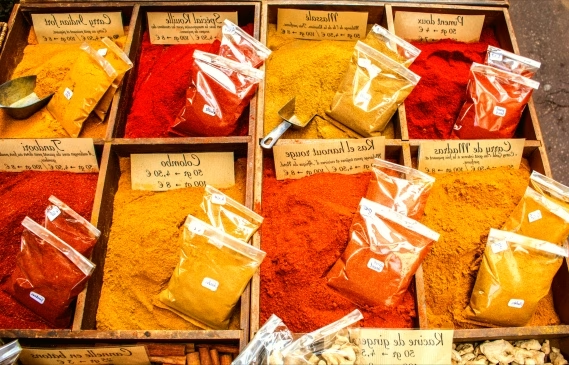The cooking principle of Thai curry is chopping, pounding, and boiling. All spices are pounded into a paste in a stone mortar. Dry spices may or may not be roasted first. The main ingredients are dried and fresh spices, as well as shrimp paste. Thai curry comes in three main types: red, yellow, and green. The resulting dishes are categorized as thick and soupy, and with or without coconut milk.
Differences Between Thai and Indian Curry
Thai curry is less complex in its use of dried spices than Indian curry, often using coriander seeds, cumin seeds, and peppercorns, while Indian curry often uses cumin, aniseed, cinnamon, cloves, and peppercorns. Thai curry is traditionally eaten with rice. However, southern Thailand, heavily influenced by Indian cuisine, often has a stronger and spicier flavor.
Common Seasonings for Thai Curry
- Coconut Cream / Coconut Milk
Coconut cream refers to the milk that is filtered out after boiling fresh coconut flesh with water. The first milk is called coconut milk, and the second is called coconut milk. Coconut cream is thicker and has a higher fat content than coconut milk. Coconut cream can also be diluted with water to become coconut milk.
- Kapi / Shrimp Paste
An ingredient in curry paste, it adds umami and saltiness. This fermented shrimp-based paste is known for its savory flavor. In Indonesian cuisine, it’s often combined with tamarind and vinegar to make sambal sauce. If shrimp paste is used in a dish, be sure to reduce the amount of salt.
- Palm Sugar
Palm sugar is a natural, raw sugar extracted from palm tree nectar or the sap of palm fruit.
- Fish Sauce
It’s commonly used in Southeast Asian cuisine to add umami and saltiness. Small fish and shrimp are pickled, fermented, and then boiled to create an amber-colored sauce.
- Turmeric
This is a type of small ginger with a brown rhizome. When fresh, turmeric is peeled, its interior is orange, similar to a carrot, and it is often used to enhance the flavor of dishes.
- Indian Curry Powder
Indian curry powder is a blend of spices with a rich aroma and a pungent spiciness. It is ideal for pickling and stewing.
- Red Curry Paste
Thai curry paste, with its red color, comes from chili peppers. The spices and herbs are blended into a puree. Generally, red curry paste is less spicy because it uses deseeded dried chilies and fresh chilies, removing their seeds and capsules, thus removing the most pungent part.
- Green Curry Powder
Green curry powder and green curry paste share the same ingredients, but the cooking process differs. The paste must first be sautéed with oil to create a thick consistency, while curry powder cannot be sautéed; it can only be mixed into the ingredients.
- Green Curry Paste
Green curry paste is made with green chilies, kaffir lime peels, and cilantro. The more fresh chilies used, the spicier the curry paste, and vice versa. The unique aroma of kaffir lime cannot be replaced with ordinary lemon peels, as the flavor difference would be significant.
- Yellow Curry Paste
Yellow curry paste gets its yellow color from turmeric. Thai yellow curry paste contains many spices, including galangal, garlic, shallots, and shrimp paste. It has a rich aroma and flavor and is very popular with seafood dishes.
- Tamarind
Also known as sour beans or sour beans, there are two types of tamarind. Sweet tamarind can be eaten raw, while sour tamarind can be used in beverages, jams, candies, and more. Sour tamarind is used in dishes to add acidity or sweetness. Thais believe that it can remove impurities from the blood and unclog blood vessels.
How to Make Green Curry Paste
Green curry gets its color from lemon zest and green chilies, while coriander roots add flavor. Green curry uses coriander and cumin seeds, just like red curry, but for massaman curry, they must be dry-fried first until fragrant.
Ingredients
Coriander seeds | 4 tsp
Fennel seeds | 2 tsp
Salt | 1 tsp
White peppercorns | 4 tsp
Coriander roots | 4 tbsp
Fresh green chilies | 4 stalks
Fresh green chilies | 4 stalks
Kaffir lime peel | 4 tsp
Galangal | 3 tbsp
Lemongrass | 4 tbsp
Garlic | 6 tsp
Shallots | 3 tbsp
Shrimp paste | 4 tsp
Steps
- Mince the garlic, shallots, cilantro roots, lemon zest, galangal, and lemongrass. Deseed and finely chop the fresh green chilies and fresh green chilies.
- Pour the ingredients into the mortar in the order listed and pound each one until it is pureed before adding the next.
- Make sure each ingredient is thoroughly pureed before adding it to the mortar.
- If there are still many small pieces after pounding, you can add appropriate amount of salad oil and use a food processor to help break them up.


Leave a Reply